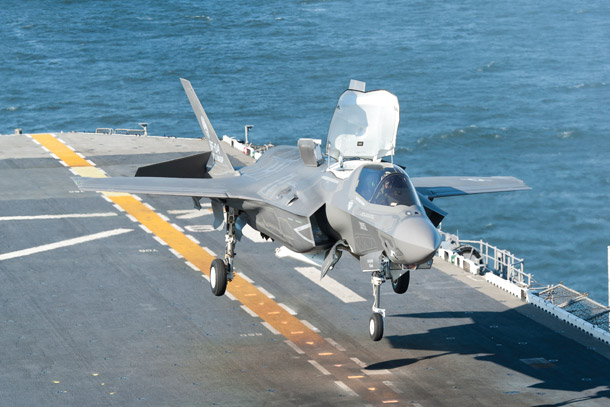Fighter aircraft could be utilised as surveillance assets to avoid stovepipe operations and allow more data to be collected and exploited in future conflicts, a Royal Air Force officer claims.
In the current operational command structure, combat aircraft and intelligence, surveillance and reconnaissance (ISR) assets are split into two areas of command, thus stovepiping each type, the RAF officer told the SMi ISR conference in London.
“We need to find a way of jolting the system to bring us back to a single operation,” he notes. “The fast jets now have as much capability to collect ISR data as the big traditional [ISR] planes, but they don’t have the capability to process and disseminate it.”
The UK’s introduction of the Lockheed Martin F-35 Lightning II Joint Strike Fighter will test this theory, as the type boasts a sophisticated active electronically scanned array radar, which will provide “phenomenal capability”.
“We need to be able to exploit this and use all of that data being collected from the Lightning,” the officer notes.

Lockheed Martin
Furthermore, the officer claims future operating environments will be difficult in comparison to past operations in Afghanistan, where it was relatively simple for fast jet and ISR aircraft to operate because the enemy’s air capability was limited.
The Islamic State militants terrorising large parts of the Middle East, including Iraq and Syria, are financially supported, the officer says, by money from the sale of oil. This means IS may be able to purchase technology such as night-vision goggles and handheld identification friend-or-foe scanners that adversaries in Afghanistan would never have been able to fund.
“They are the military acting in a non-military guise… this enemy has a brain,” he adds.
China and Russia, meanwhile, have advanced offensive cyber-warfare capabilities – more so than many Western nations – that would allow them to disrupt datalinks. All it takes is the jamming of one frequency to disrupt the flow of information in an operation.
“We need to be agile and be able to hop on to other frequencies,” the officer says.
GPS is utilised in a wide range of weapon and sensor systems, so jamming this system could jeopardise a mission. Opponents may not be able to jam the whole GPS network, the representative adds, but could do so locally in areas of operation.
“It’s not just a case of what we are technologically capable of now, it’s more a case of what the enemy can do and how they can influence where we position our assets,” he notes.
The amount of data generated by ISR assets on the battlefield is also of concern. Due to the large amount of data collected most could not be analysed, and therefore only a small percentage was turned into “actionable intelligence” that could be utilised in operations during the UK’s participation in Afghanistan.
“We probably need to be a bit more savvy about what data we move around the battlespace and what we keep on the host platform,” the officer says.
Multiple data streams need to be turned into intelligence, so data needs to be fused and “acted on dynamically”. All data needs to be streamlined in one area so that somebody has all the available information to make a decision.
“We need to be able to act on information even quicker,” the officer adds.
Source: FlightGlobal.com



















